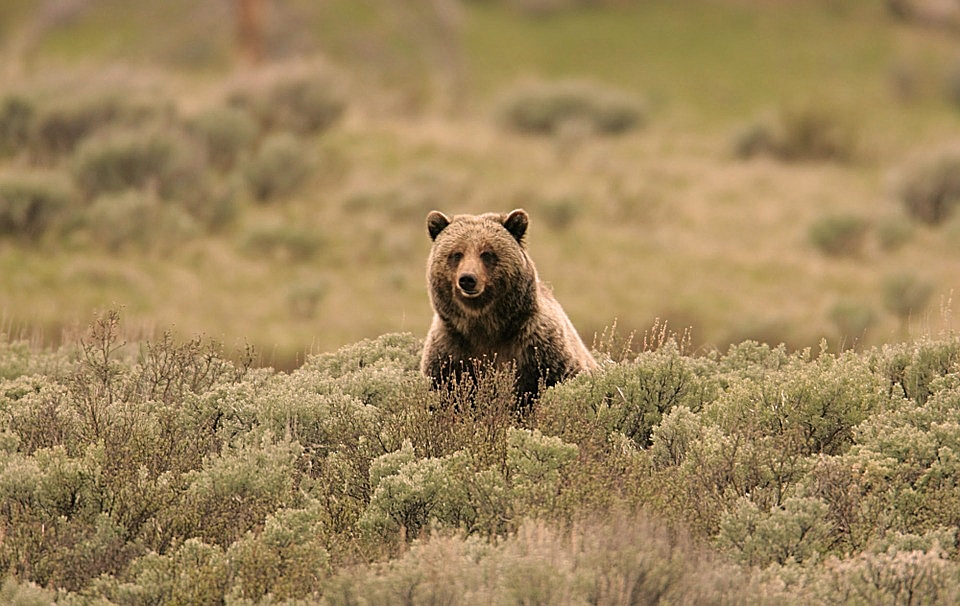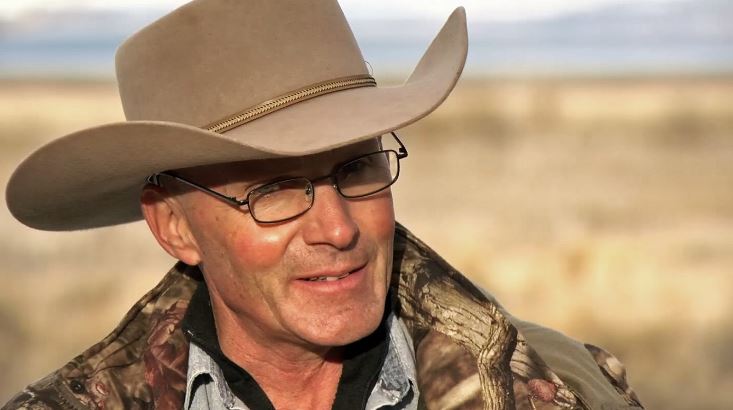Within the ESA, extensive (unconstitutional) powers are given to the federal government to limit activities on state and private lands. For this reason, various agencies, including the Forest Service, Bureau of Land Management, and Fish & Wildlife, and numerous extreme environmental groups, have used the ESA to halt development on state and private lands, even to the point of shutting down industry, and interfering with property owners utilizing their own land and water.
by Marjorie Haun
A Thursday press release issued by the U.S. Fish & Wildlife Service announced the agency’s long-awaited decision to take the Yellowstone Grizzly off the Endangered Species list. It also cited Interior Secretary Ryan Zinke’s comments regarding his department’s determinations. It reads:
Due to the success of conservation efforts and collaboration among a variety of stakeholders, U.S. Secretary of the Interior Ryan Zinke announced today that the Yellowstone population of the grizzly bear has been recovered to the point where federal protections can be removed and overall management can be returned to the states and tribes. The population has rebounded from as few as 136 bears in 1975 to an estimated 700 today and meets all the criteria for delisting.
“As a kid who grew up in Montana, I can tell you that this is a long time coming and very good news for many communities and advocates in the Yellowstone region,” said Secretary Zinke. “This achievement stands as one of America’s great conservation successes; the culmination of decades of hard work and dedication on the part of the state, tribal, federal and private partners. As a Montanan, I’m proud of what we’ve achieved together.”
The Greater Yellowstone Ecosystem (GYE) Distinct Population Segment (DPS) consists of portions of northwestern Wyoming, southwestern Montana and eastern Idaho. Grizzly bear populations outside of this DPS in the lower 48 states will be treated separately under the ESA and will continue to be protected.
The GYE grizzly bear population is one of the best studied bear populations in the world thanks to the longstanding efforts of the Interagency Grizzly Bear Study Team (IGBST). Population and habitat monitoring efforts undertaken by the IGBST indicate that GYE Grizzly Bears have more than doubled their range since the mid-1970s. They now occupy more than 22,500 square miles, an area larger than the states of New Hampshire, Massachusetts and Connecticut combined. Stable population numbers for grizzly bears for more than a decade also suggest that the GYE is at or near its capacity to support grizzly bears. This decision by the U.S. Fish and Wildlife Service (USFWS) was informed by over four decades of intensive, independent scientific efforts.
The delisting of a species such as the Yellowstone Grizzly is an occurrence almost a rare as the most endangered of species on the list; it just doesn’t happen very often. In February of this year, Senator John Barrasso of the Senate Committee on Environment and Public Works, commented on the lack of species recovery and delisting. He said:
“Here’s the problem – the Endangered Species Act is not working today.
“We should all be concerned when the Endangered Species Act fails to work.
“States, counties, wildlife managers, home builders, construction companies, farmers, ranchers, and other stakeholders are all making it clear that the Endangered Species Act is not working today.
“A major goal of the Endangered Species Act is the recovery of species to the point that protection under the statute is no longer necessary.
“Of 1,652 species of animals and plants in the U.S. listed as either endangered or threatened since the law was passed in 1973, only 47 species have been delisted due to recovery of the species.
“In other words, the Fish and Wildlife Service has concluded that less than 3 percent of species in the United States under the protection of the Endangered Species Act have recovered sufficiently to no longer necessitate the protection of the statute.
“As a doctor, if I admit 100 patients to the hospital and only 3 recover enough under my treatment to be discharged, I would deserve to lose my medical license.
One of the key defects in the Endangered Species Act (ESA) is its lack of clear criteria in quantifying what successful species recovery looks like. And, although the ESA sets forth harsh and extensive punishments where its provisions are violated, there is nothing in the act that repeals restrictions, fines and penalties once a species meets recovery criteria and is delisted. Following the Yellowstone Grizzly announcement, Rob Bishop, Chairman of the House Committee on Natural Resources said this:
“I commend this Administration and the Department of the Interior for delisting the grizzly bear even though it should have been done years ago. States are far more capable of managing the grizzly population than the federal government. The time it took to get this delisting is the latest evidence that reform of ESA is sorely needed. Recovery and delisting — and responsible state management that will prevent listings in the first place — must be the goals of ESA, not lifetime sentences on the endangered list fraught with frivolous litigation.”
Chairman Bishop is correct in his assertion that states would do a far better job of managing grizzly populations, and other threatened and endangered species. The ESA as it stands, is a one-size-fits-all policy that, when it comes to management and recovery of thousands of species across countless, diverse ecosystems, is cumbersome, imbalanced, and prone to excesses and abuse.
Within the ESA, extensive (unconstitutional) powers are given to the federal government to limit activities on state and private lands. For this reason, various agencies, including the Forest Service, Bureau of Land Management, and Fish & Wildlife, and numerous extreme environmental groups, have used the ESA to halt development on state and private lands, even to the point of shutting down industry, and interfering with property owners utilizing their own land and water. Instances where landowners acting to protect their property rights by ensuring that no endangered or threatened species are found on their lands, have caused the reverse effect intended by ESA.
The Property & Environment Research Center (PERC) published a report on the ESA’s impact on private and state property. The author, Richard Stroup, points out:
The ESA, as interpreted by the Fish and Wildlife Service, calls for FWS biologists to control how land is used any time they consider it important for listed species. They decide whether farming, or logging, or building or even walking the land will be allowed. On such land, private or public, the FWS biologists become, in effect, land managers on behalf of the listed species. (The National Marine Fisheries Service has the responsibility for ocean-going fish.)
When a northern spotted owl, red-cockaded woodpecker, or other species listed as endangered or threatened is found on private property, the owners are required to meet the demands of the Fish and Wildlife Service biologists. Yet the biologists have no economic incentive to limit their demands. Since they have no requirement to compensate the owners of the land they control, other people’s land has no budgetary cost to them; it is available free of charge.
In fact, however, land is a scarce good. The landowner who has listed species on his or her land, or who has habitat that might attract listed species, may not willingly offer it up free simply because Fish and Wildlife Service officials think they need it. Yet according to the law, the government has no obligation to consider the wishes of the owner or compensate the owner for taking control away.
The result is not only animosity on the part of landowners, animosity that is fully justified. It is also damage to the species that the biologists want to protect. This ability to control how property is used makes an enemy out of even the most harmless of birds or other listed species. In other words, by focusing the enormous power of the federal government on the supposed protection of rare species, the Act has made rare species unwanted and has even encouraged some people to get rid of them. This explains the paradox of the Act’s enormous power and minimal results.
Although the Trump Administration, with Ryan Zinke heading up Interior, is determined to correct threats to private property rights and resource development posed by ESA, it’s a slow process, and radicals on the environmentalist/animal rights Left, are determined to fight needed reforms tooth and nail. The ESA, though dysfunctional, provides a platform for the extreme greens to sue the pants off federal agencies, lock up lands, water, and other resources, and at the same time, take in millions of dollars in ESA ‘sue & settle’ schemes. Consider the ongoing spotted owl brouhaha, which is responsible for the near-death of the timber industry in America’s Pacific Northwest, and the loss of countless jobs. The misapplication of ESA in an attempt to ‘protect’ the spotted owl has driven hundreds of communities into desperation and poverty. Despite severe restrictions on logging operations in the Pacific Northwest, spotted owl populations, it turns out, have continued to decline. Why? It has nothing to do with trees, and everything to do with owls; in this case, the barred owl, which preys on spotted owls. It’s owl vs. owl, and a lot of working families in California, Oregon and Washington have paid a steep price. The solution of wildlife biologists has been to kill barred owls in order to reduce predation on spotted owls. And all the while, rural, resource-based communities in the Northwest are sliding into economic oblivion.
It’s high time the ESA is reformed, realigned with science, and grounded in sound economic incentives. This incredibly powerful law has failed to protect species to the extent intended, but it has succeeded in destroying local economies, and driving property owners to desperate measures to order to defend their rights against this intrusive and unreasonably punitive federal policy.
Free Range Report
[wp_ad_camp_3]




I sold several hundred acres of farmland in Colorado in 2002, where I regularly saw Black Footed Ferrets while irrigating my fields. This animal was considered very rare and endangered at the time. I can tell you that they are not rare nor are they endangered. I did not mention the sighting to anybody, especially any government entities, and for all the reasons stated in your excellent article, Marjorie.
Any issue having to do with EPA, Interior, or the ESA is a problem for rural landowners. Contact with the government should be limited to a friendly greeting, and nothing else. My response when specifically asked about the Black Footed Ferret, and I was asked, was, “A what?”